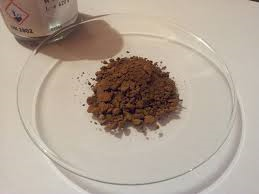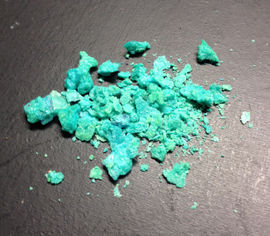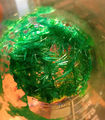Copper(II) chloride
 Anhydrous copper (II) chloride
| |
 Pieces of copper(II) chloride dihydrate
| |
| Names | |
|---|---|
| IUPAC name
Copper(II) chloride
| |
| Other names
Copper dichloride
Cupric chloride Cupric dichloride | |
| Properties | |
| CuCl2 (anhydrous) CuCl2·2H2O (dihydrate) | |
| Molar mass | 134.45 g/mol (anhydrous) 170.48 g/mol (dihydrate) |
| Appearance | Brown solid (anhydrous) Blue-green solid (dihydrate) |
| Odor | Odorless |
| Density | 3.386 g/cm3 (anhydrous) 2.51 g/cm3 (dihydrate) |
| Melting point | anhydrous 498 °C (928 °F; 771 K) dihydrate 100 °C (212 °F; 373 K) (dehydrates) |
| Boiling point | 993 °C (1,819 °F; 1,266 K) (anhydrous, decomposes) |
| 70.6 g/100 mL (0 °C) 75.7 g/100 mL (25 °C) 107.9 g/100 mL (100 °C) | |
| Solubility | Soluble in acetone, ethanol, conc. HCl, methanol |
| Solubility in ethanol | 53 g/100 mL (15 °C) |
| Solubility in methanol | 68 g/100 mL (15 °C) |
| Vapor pressure | ~0 mmHg |
| Hazards | |
| Safety data sheet | Sigma-Aldrich (anhydrous) Sigma-Aldrich (dihydrate) |
| Flash point | Non-flammable |
| Related compounds | |
| Related compounds
|
Copper(I) chloride |
| Except where otherwise noted, data are given for materials in their standard state (at 25 °C [77 °F], 100 kPa). | |
| Infobox references | |
Copper(II) chloride, also known as cupric chloride, is an ionic compound of copper and chlorine with the formula CuCl2. It is a brown solid when anhydrous, but turns a brilliant turquoise color when hydrated.
Contents
Properties
Physical properties
Copper(II) chloride is a brown powder that turns red when molten. Its melting point is 498 °C. Copper(II) chloride is hygroscopic and absorbs water in open air to form the dihydrate, which is a neutral tetracoordinate complex. The material normally exists as a brilliant turquoise powder, but thin, transparent, fragile crystals may be grown.
Chemical properties
In the presence of excess chloride ions, copper chloride will form a greener colored acidic copper(II) chloride, in which the water ligands are substituted for chloride ions. If hydrochloric acid is added to an aqueous solution of copper(II) chloride, tetrachlorocupric acid is formed.
- 4 H+ + 8 Cl- + 4 CuCl2- + O2 → 4 CuCl42- + 2 H2O
Copper(II) chloride can oxidize and dissolve aluminium, owing to the formation of the tetrachlorocuprate ion. Besides this, it is a moderate oxidizer and will also dissolve other reactive metals such as zinc and magnesium. It is also useful in organic synthesis because it can chlorinate the alpha position of carbonyls. In the presence of oxygen, it can also oxidize phenols.
Copper(II) chloride burns at low temperature with a deep blue flame (or green, depending on impurities). If the flame temperature is too high, it breaks down and gives a more greenish flame color. For this reason, it cannot be used in fireworks to obtain blue flame.
Availability
Copper chloride can be purchased from chemical suppliers or online from eBay and Amazon. ScienceCompany sells 100 g of copper(II) chloride dihydrate at 11.95$.
Preparation
Copper(II) chloride can be produced by adding copper metal to a mixture of hydrochloric acid and hydrogen peroxide.
- 2 HCl + H2O2 + Cu → CuCl2 + 2 H2O
Copper is resistant to attack by pure hydrochloric acid and other non-oxidizing acids, so an oxidizer must be added to promote dissolution (in this case, hydrogen peroxide).
Copper(II) oxide or hydroxide can be used instead of copper metal.
- 2 HCl + CuO → CuCl2 + H2O
- 2 HCl + Cu(OH)2 → CuCl2 + 2 H2O
Totally anhydrous copper(II) chloride can be made by passing dry chlorine gas over hot powdered copper metal.
Projects
- Make copper(I) chloride
- Make the trichlorocuprate ion
- Make blue-green fire
- Moisture indicator
Handling
Safety
Copper(II) chloride is toxic and corrosive, so proper protection, such as gloves should be worn when handling the compound.
Storage
Copper(II) chloride should be stored in closed containers, to keep it dry. The anhydrous form should be kept in sealed containers or in a desiccator.
Disposal
Copper(II) chloride must be reduced to copper metal with with another more reactive metal, such as iron or zinc to form iron(II) chloride or zinc chloride which are less toxic, before being disposed of.
